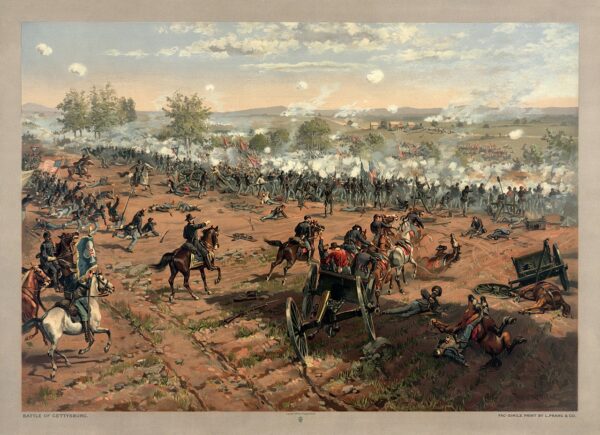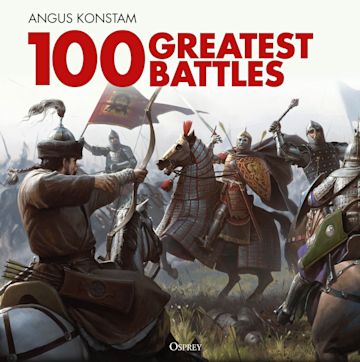


What are history’s greatest battles? Angus Konstam, author of more than 100 history books, tackles that question with his latest book, “100 Greatest Battles.” The author begins his selection in the fifth century B.C. with the battles of the Greco-Persian Wars, then moves through the next 2,500 years to the battles that made up the 20th century.
The book is not a deep dive into the history of warfare, as each battle is detailed in about 500 words. Each two-page section has artwork provided by Osprey Publishing artists, along with a description of the image, often demonstrating a significant moment with a specific battle. The book is more a collector’s item for history or military history enthusiasts. In that same vein, it is a great book to introduce young readers to the world of military history, which also proves to be a fine introduction into geopolitical history.
What is fascinating about Konstam’s work is how much he is able to discuss in such a short amount of space. He is able to introduce historical figures, the battle and its outcome, and how that gave way to other battles or ended the conflict between two nations, cultures, religions, or ideologies. “100 Greatest Battles” is an ideal work for receiving a crash course in military history and how it affected the world through the centuries. Each battle hints at how empires rose and fell, how religion played a role in combat, and how strategic blunders in singular battles could quickly change the course of history.
Concerning the battles themselves, there doesn’t seem to be a specific formula for choosing them. Some battles are chosen for their importance in defeating empires or kingdoms, while some result in the creation of empires or kingdoms. Some are chosen due to their mass scale. Some by their sheer historical significance.
Konstam demonstrates in several instances that victory isn’t necessarily a requisite to be considered a great battle. Examples are the Battle of Thermopylae, which makes the list because of the legend created by the story of the 300 Spartans, though the result ultimately led to the destruction of Athens. Another example is the Battle of the Alamo: Although the heavily outnumbered Texans were defeated by the Mexicans, the battle created a rallying cry for the Battle of San Jacinto, which resulted in Texas becoming its own republic.
There is just enough detail in each battle for readers to conduct further research. Ranging from historical leaders, battle locations, and battle strategy, readers will be introduced to people like Darius, Julius Caesar, and Napoleon Bonaparte, and even some more obscure names like Duke Odo, Prince Alexander Nevsky of Novgorod, and Francisco Pizarro. These 100 battles take place across the globe, from South America to Africa to Europe to Asia, and strategic methods—like the double envelopment, the feigned retreat, and long sieges—are discussed. The book is a testament that one event, and even one man, can change the course of history.
Reading through the book, one is reminded how superior numbers, though important, aren’t always necessary. There are numerous times in the book where strategy and the evolution of firepower become the equalizer when outnumbered. The book also plays compliment to the genius of some of the past military leaders, like Genghis Khan, Horatio Nelson, and Douglas MacArthur.
Military history enthusiasts understand the impact warfare has on geography. For modern times, one only needs to look at the results of World War I to understand how nations were created, new national boundaries were drawn, and how empires were either strengthened or dismantled.
As powers rise and fall, the ages come and go. Konstam breaks up his book into nine eras: the Ancient World (490 B.C.–451 A.D.), the Medieval World (718–1485), the Renaissance (1521–1690), the Age of Reason (1704–1781), the Napoleonic Era (1793–1815), the Age of Empires (1836–1905), World War I, World War II, and the Modern Age (1950–1991).
Although the battles are centered on specific locations and times, Konstam often provides background as to why these battles take place, discussing years, if not decades of prior military conflicts or power struggles.
There is no drama like military drama. Konstam’s fun and engaging book solidifies the fact that warfare is part of human nature, even when we try to avoid it. It’s a reminder that wars start for countless reasons, and one of the reasons is because of past wars.
The book lists the battles in chronological order rather than in order of importance. Indeed, that is part of the enjoyment of reading the book and possibly having a discussion with family, friends, or students―a discussion of which battles were the most important. The author leaves this conversational window wide open. He has simply done the service of providing readers and history enthusiasts with the material to appraise according to their own views. It makes a fun book even more fun.
‘100 Greatest Battles’
By Angus Konstam
Osprey Publishing, April 25, 2023
Hardcover: 224 pages


